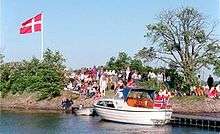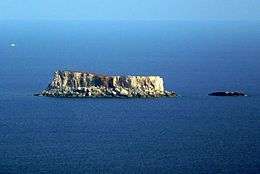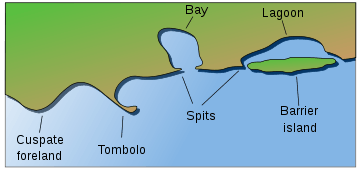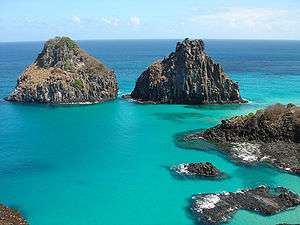Islet
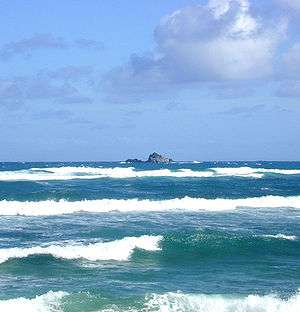
An islet is a very small island.
Types
As suggested by its origin as islette, an Old French diminutive of "isle",[1] use of the term implies small size, but little attention is given to drawing an upper limit on its applicability.
- Cay or Key – an islet formed by the accumulation of fine sand deposits atop a reef
- Motu – A reef islet formed by broken coral and sand, surrounding an atoll.
- River island – A small islet within the current of a river.
- Rock – A "rock", in the sense of a type of islet, is an uninhabited landform composed of rock, lying offshore, and having at most minimal vegetation.
- Sandbar – An exposed sandbar is another type of islet.
- Sea stack – A thin, vertical landform jutting out of a body of water.
- Skerry – A small rocky island, usually defined to be too small for habitation.
- Subsidiary islets – A more technical application is to small land features, isolated by water, lying off the shore of a larger island. Likewise, any emergent land in an atoll is also called an islet.
- Tidal island – Often small islands (not necessarily always islets) which lie off the mainland of an area, being connected to it in low tide and isolated in high tide.
Synonymous terms

- In the Caribbean and West Atlantic, islets are often called cays or keys. Rum Cay in the Bahamas and the Florida Keys off Florida are examples of islets.
- In the Channel Islands, they are often identified by the suffix -hou from the Norse -holm.
- In Scotland and Ireland, they are often called inches, from the Gaelic innis, which originally meant island, but has been supplanted to refer to smaller islands. In Ireland they are often termed skerries.
- In and around Polynesia, islets are widely known by the term motu, from the term for the coral-rubble islets common to the region.
- In and around the River Thames in England, small islands are known as aits or eyots.
In international law
Whether an islet is considered a rock or not can have significant economic consequences under Article 121 of the UN Convention on the Law of the Sea, which stipulates that "Rocks which cannot sustain human habitation or economic life of their own shall have no exclusive economic zone or continental shelf." One long-term dispute over the status of such an islet was that of Snake Island (Black Sea).[2][3][4]
The International Court of Justice jurisprudence however sometimes ignores islets, regardless of inhabitation status, in deciding territorial disputes; it did so in 2009 in adjudicating the Romania-Ukraine dispute, and previously in the dispute between Libya and Malta involving the islet of Filfla.[2][5]
List of islets
There are thousands of islets on Earth: approximately 24,000 islands and islets in the Stockholm archipelago alone. The following is a list of example islets from around the world.
Notes
- ↑ Webster's New International Dictionary of the English Language, Second Edition, 1958
- 1 2 Coalter G. Lathrop (July 22, 2009) "Maritime Delimitation in the Black Sea (Romania v. Ukraine)". American Journal of International Law, Vol. 103. SSRN 1470697
- ↑ Ukraine, Romania spar over islet, UPI 2006-7-14
- ↑ Romania and Ukraine avoid rocky horror show, Euronews, 03/02/09
- ↑ Hance D. Smith (1991). The Development of Integrated Sea Use Management. Taylor & Francis. p. 82. ISBN 978-0-415-03816-4.
References
- Clive Schofield (2012). "Islands or Rocks, Is that the Real Question? The Treatment of Islands in the Delimitation of Maritime Boundaries". In Myron H. Nordquist, John Norton Moore, Alfred H.A. Soons, Hak-So Kim. The Law of the Sea Convention: US Accession and Globalization. Martinus Nijhoff Publishers. pp. 322–340. ISBN 978-90-04-20136-1.
